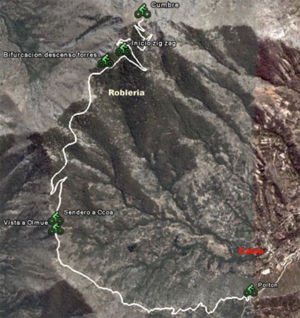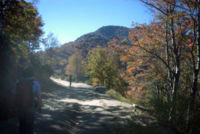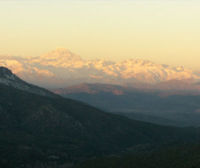Diferencia entre revisiones de «Cerro el Roble (ruta vehicular) (english)»
| Línea 7: | Línea 7: | ||
| − | {{ | + | {{Access to Caleu}} |
==Route Description== | ==Route Description== | ||
Revisión del 15:47 28 jun 2009

|

|
Contenido
Season
This trek can be done year round, but the ideal time is May, when the Oak trees are red, orange, and yellow. The winter months are also good when the Andes are covered in snow, and there is a beautiful view to the Aconcagua and company. For those who chose to ascend by bike, you should be careful in those days that just after a front of bad weather, snow has fallen on the peak. During those days (4 or 5 days a year) it can be necessary to carry your bike on the final stretch.
Access
By car
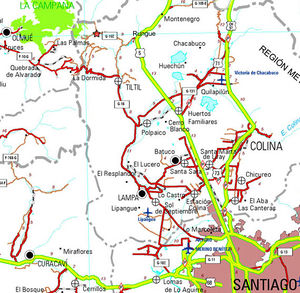
From Santiago, you must take the Pan-American highway (route 5) in the north direction. The detour to Rungue is at kilometer 54. You must take that exit and enter the town. Where the street ends, we must turn left and, a few meters further on, turn right (the street ends anyway) to cross an estuary. Immediately after crossing the estuary, you should turn left, and begin to skirt the estuary along a gravel road in good condition. The Rungue reservoir will then be bordered. After 3.9 kilometers from the Pan-American highway, there is a detour to the right ("A Caleu") which must be taken. This road, also gravel in good condition, goes through the valley and ascends progressively. Approximately on the 11th kilometer from the turnoff (14.9 from the Pan-American Highway) Caleu has been reached and a fork arises: you must take the left, which continues up the hill. 970 meters above, just before the passage to the valley of Olmué, the path to the oak tree appears on the right.
In public transport and hitchhiking
From the La Paz bus terminal, located on Avenida La Paz and Dávila Baeza street, daily buses depart for Til Til, from 6 AM and every 15 minutes. At 16.00, a bus leaves for Caleu. Passage value $ 1,600. It is quite a busy road, so the possibilities of hitchhiking are rather high.
Route Description
The route begins at the gate, where you must pay for the access. The path is clear to peak, since it is a vehicle road built for the construction and maintenance of the antennas at the peak. On a normal weekend (specially after a snowfall), you should find a few cars on the road. From the access gate, start west. The road ascends without stopping up to the peak. The first stretch is through the south edge of the hill. It then reaches the edge that divides the valleys of Caleu and Olmué. Towards the west you will have beautiful views of the Ocoa palm grove and La Campana. Briefly after this first view of the valley of Olmué, a pedestrian fork appears to the path that leads to Ocoa. For the peak of El Roble, continue up the main vehicle road. You will then pass by a wooden fence to the left. Then the road penetrates the Oak forrest, and then begins a hard zig-zag. Little before the peak, you will be able to see some of the transmission towers. The peak is a relatively large plain, with installations for telecommunication services that take away from the feeling of being outdoors, but the view is nevertheless beautifully impressive.Estimated Time
- Trekking: 4 hours from the gate. It is possible to continue a little more by car and reduce the walking time.
- Mountain Bike: 2,5 hours from the gate.
Permisos / Tarifas
- Se deben cancelar CLP$4000 (US$ 4.2 as of November 2024) por adulto para ingresar (niños gratis). El ingreso es administrado por la Asociación de Comuneros Capilla de Caleu, y está abierta fines de semanas y festivos de 9 a 13 horas. En caso de ir un día hábil y querer cruzar el portón en auto, se debe llamar al celular +56984759457 o al +56962382245.
Recommendations
It is recommended to do the ascent stretch on the vehicle road when it has snowed in Santiago. It can be done in randonnée or rackets, low difficulty.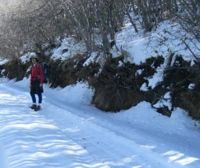
Route and Waypoints on Google Earth
- Ruta del Cerro El Roble. Para descargar el archivo se recomienda hacer click con el botón derecho del mouse y luego seleccionar "Guardar destino como" (Internet Explorer), "Guardar enlace como" (Firefox) o "Save link as" (Google Chrome). Si se intenta abrir directamente, algunos navegadores abrirán el código crudo del archivo con el listado de coordenadas.

